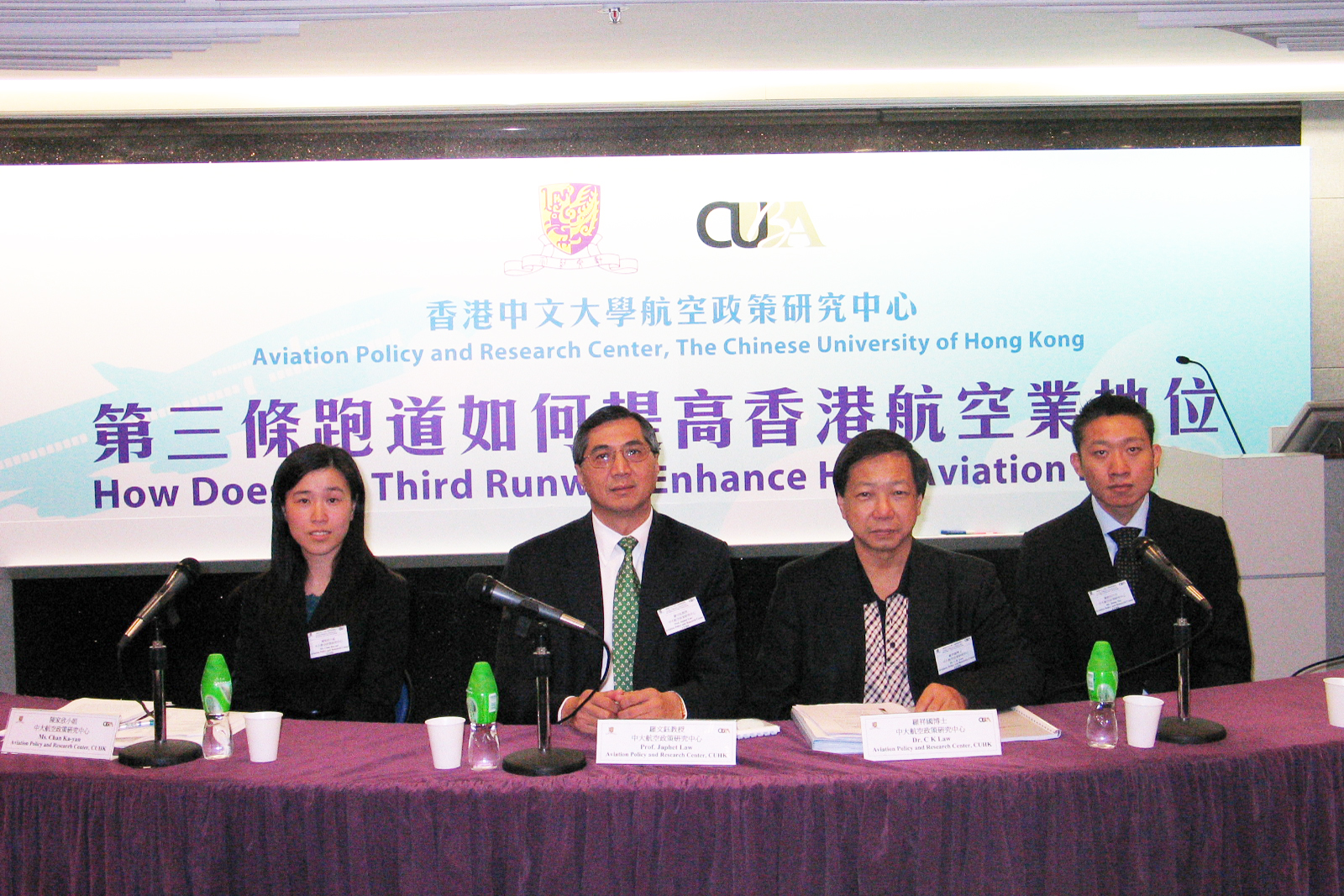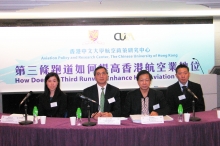CUHK
News Centre
CUHK Study on HKIA’s Third RunwayTo Enhance Hong Kong’s Aviation Position
In recent years, Hong Kong’s air transport industry benefited directly from the rapid growth of the Asia-Pacific and Chinese markets. Despite such strong growth, Hong Kong has encountered fierce competition from its regional neighbours and even within the same catchment area (the Pearl River Delta Region, PRD). Furthermore, airspace and ground congestion have become more serious over time. It is believed that the Hong Kong International Airport (HKIA) will run out of capacity at some point of time in the near future.
To cope with the increasing air traffic demand and competition, the Airport Authority Hong Kong (AAHK) published a report on ‘HKIA 2025’ in December 2006, which is a master plan outlining the future development of the Airport in meeting the future demand. The AAHK has suggested constructing a third parallel runway with around 1km separation from the current north runway. However, diverse views have been received from both the industry and the public about the proposal.
The Aviation Policy and Research Center (APRC) at The Chinese University of Hong Kong has carried out a study to evaluate the importance of the third runway and to estimate the timing when this third runway “should be ready” so as to prevent significant impairment to our economy due to delay of the project.
Although many enhancement measures could help improve the efficiency of the Airport and thereby expand its overall capacity before a third runway is in place, the Airport would eventually reached its “ultimate capacity”. By that time, the third runway should be ready for service to prevent any possible economic loss against fierce competition with other airports in the region. Taking the experience of Manchester Airport and Heathrow Airport as reference, if all possible ATM (Air Traffic Management) and ATC (Air Traffic Control) enhancement measures are implemented, the “ultimate capacity” of the parallel runways of HKIA is estimated to be 80 movements per hour under the most ideal situation. However, variables like weather condition, airspace situation and the types of aircrafts that flying into and out of Hong Kong will affect the runway capacity under practical operation. Therefore, the actual capacity of the parallel runways of HKIA is usually less than 80 movements per hour. According to HKIA’s more conservative forecast of traffic demand growth of 3% annually, this ultimate capacity will be reached by 2019/20. However, if we assume a more realistic traffic growth rate: 5% or 7%, HKIA would reach its capacity by 2014/15 and 2011/12 respectively instead.
Under the current political and social environment in Hong Kong, this study estimates that it would take about 12 years to build a new runway, from the initial planning and design, through public consultation, construction, to completion. According to this calculation, we could barely have the third runway ready before our capacity runs out even if we accept the “conservative” estimation of a 3% growth rate in demand. However, if we use a more “realistic” growth rate of 5% and 7% in demand, we are already 3 to 6 years behind schedule in starting the initial planning and design stage. Therefore, the need to immediately expedite the initial study and planning for the third runway is extremely urgent.
By using the latest official statistics, we estimated that one additional flight would bring an economic contribution to Hong Kong by HK$0.45 million (the direct contribution is HK$0.17 million and the in-direct contribution is HK$0.28 million). Using a “middle-of-the-road” benchmark of 5% traffic growth rate, medium pollution cost, and an average runway capacity increase of 30% for the third runway scenario, it is estimated that the annual economic contribution to Hong Kong’s economy from a fully utilized third runway would be HK$56 billion when comparing with the absence of a third runway. The corresponding estimation of the partial cost of pollution is approximately HK$0.4 billion. This figure can be considered negligible in numeric terms when comparing with the economic values generated by the additional flights.
In view of the recent announcement of a proposed linkage (by high speed rail) between the HKIA and Shenzhen’s Bao’an Airport, the potential impact of such a linkage should be assessed. The proposed linkage will not only impact on the future passenger and cargo demand for HKIA, but also have possible influence to the flight mix of the Airport. On the other hand, the combined environmental impact of major infrastructure projects (such as the proposed bridge-land interface point at HKIA for the Hong Kong-Zhuhai-Macau Bridge) within the same vicinity may further complicate the environmental impact assessment work of such projects. While aviation industry is a key asset of the South China region, CUHK’s Aviation Policy and Research Center suggests that it is important to formulate a more inclusive and coordinated plan for the future development of the aviation infrastructures in the PRD Region.





